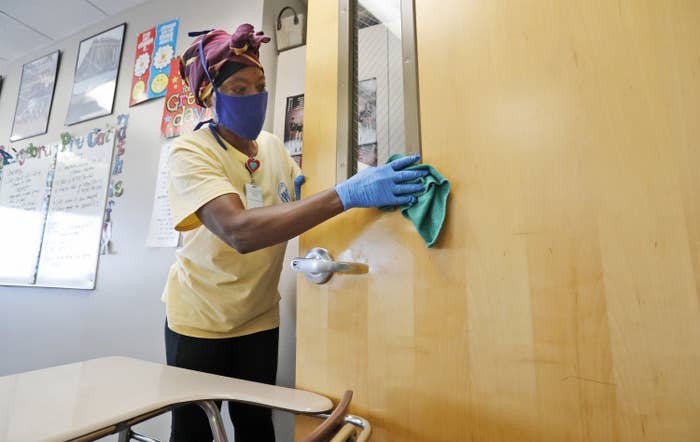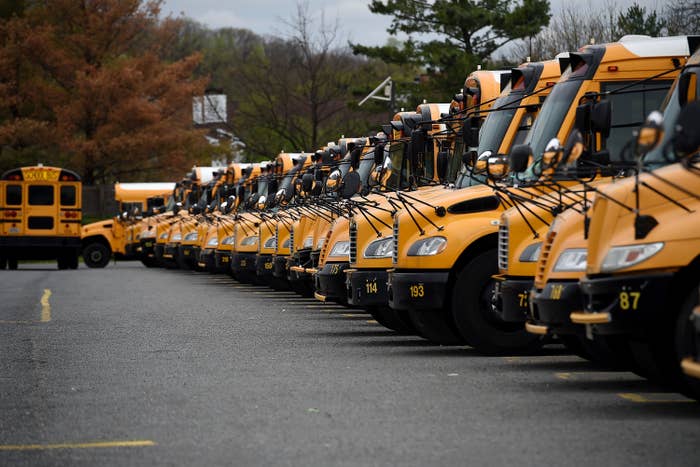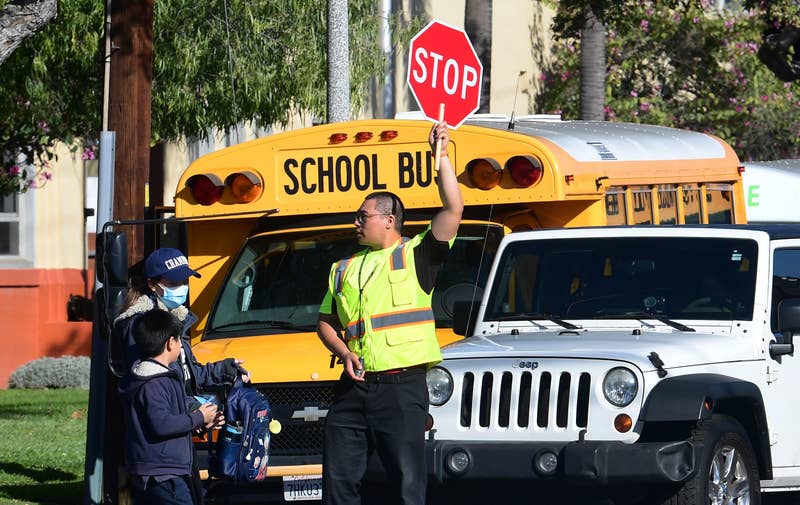Back To School: Teachers Are Ready To Quit Rather Than Put Their Lives At Risk
“Most parents have no idea how bad this is going to be.”
Caroline O'DonovanBuzzFeed News Reporter
Posted on July 16, 2020, at 6:01 p.m. ET

Lm Otero / AP
This spring, a teacher in Dallas was invited to the high school graduation of the first class of students she had taught when she became a teacher a little over a decade ago — but the ceremony was canceled because of the coronavirus pandemic. Now, just a couple months later, facing an uncertain plan for reopening schools, she’s applying for jobs in the private sector and considering quitting teaching altogether.
“At this point, if anybody were to offer me something, I would rather do that than risk my health,” she said.
Typically, the Dallas-based teacher, who requested anonymity to protect her job, teaches 25 elementary-age students in a small classroom with windows that don’t open. She has major reservations about going back, but in Texas, where cases of the coronavirus are surging and some hospitals are running out of beds, it's illegal for teachers to strike, and those who break their contracts can lose their teaching certification altogether.
Earlier this week, the superintendent of her district said at a video staff meeting that the plan is still for students to attend school in person. At the end of the meeting, he acknowledged the unprecedented difficulties and risks teachers will face.
“We appreciate you, we care about you, we want to provide the best opportunity, the best climate we possibly can,” the superintendent said, according to an employee who attended the meeting. “So many people ask me each and every day how can we support and, I don’t know if you are religious or not, but we need your prayers. We need your prayers for our children and our families.”
But many staff members’ concerns were not assuaged by this.
“Everyone on the group text was like, What do you mean, pray? It’s not comforting by any means,” the teacher said.
“I love, love my job. But this? It’s not worth my life,” she continued. “I’m scared of getting sick and bringing it to my family. I’m scared of dying. I think we all are, you know?”
The Trump administration is eager to reopen schools in part because parents can’t return to work and be efficient economic engines without childcare. But in many states, it’s proving difficult if not impossible to send kids back to school safely because businesses reopened too early, and the health system is now once again dealing with a surge in infections, hospitalizations, and deaths.
The crisis over when and how to reopen schools underscores a central contradiction in American society: It can’t function without the public school system, which doesn’t have the funding and resources to follow the basic health and safety guidelines that would make reopening schools during a global pandemic feasible.
Teachers are quick to acknowledge that remote, online learning isn’t nearly as effective as being in the classroom, but with coronavirus cases rising all over the country, many don’t feel prepared to go back, either. A lack of national leadership on the schools issue has left states to give orders and school districts to make piecemeal plans that many teachers don’t understand or trust.
While some school staffers feel ready to go back, others are so frustrated and afraid that they’ve floated the idea of organizing a national walkout similar to the 2018 and 2019 teacher strikes over low pay. But as public employees, teachers in some states are legally barred from striking, and some are afraid that breaking their contract by resigning at the last minute or organizing “sick-outs” as a form of protest could lead to them losing not just their jobs, including insurance and salary, but their teaching certifications and therefore their ability to work at all.
Rather than face that decision, Michael McCann, who taught middle school English in Virginia for the last three years, decided to quit in June. The problem, he said, is that leaders are “expecting teachers to be the glue that holds society together.”
McCann was lucky to be hired as a technical writer, a job he can do from home, just a month before his wife is due to give birth to their son in August.
Quitting his teaching jobs wasn’t an easy decision for McCann, who said he’ll miss the students he worked with last year and those he would have taught this year in eighth grade. But he ultimately felt he couldn’t reconcile the lack of leadership, and the country’s failure to get the pandemic under control, with the safety of his family.
“If they were more straightforward with the employees as far as what to expect … They keep on sending out surveys, but we don’t know what decisions are being made based on those surveys,” he said. “I’m like, Are you guys going to make this decision the week we’re supposed to start back? If they could give us some sort of secure answer or give us some comfort as far as what we’re expecting, I probably wouldn’t have applied for that position.”
McCann said he worries for his former students’ safety and education, but also for the nurses, counselors, administrators, food handlers, and other adults at school who he feels don’t have the appropriate support to deal with the crisis.

Olivier Douliery / Getty Images
School buses parked at the Arlington County Bus Depot in Virginia.
School bus drivers, some of whom are left alone with dozens of students at a time, will also experience health risks when school reopens. Buses in districts that go back on a rotating schedule will have more room for distancing, but in other areas, drivers will have to make multiple trips per morning, sanitizing buses between runs and enforcing rules about masks while also driving. The school staff union in Houston has said 80% of bus drivers are declining to come back because of health issues and age concerns related to the virus, according to KHOU.
Vicki has been driving a school bus in a city in Indiana for almost 30 years. School this year is currently scheduled to start on Aug. 5. She drives a bus for children with disabilities, so there are fewer students and an aide is available to help keep everyone safe. But she has friends who drive buses that can carry as many as 54 students at a time, and she’s worried about their safety.
“I’d be a lot more nervous if I had to drive a big bus,” said Vicki, who asked to be identified only by her first name. “I am worried some about myself getting sick but more worried about possibly being a carrier and giving it to others in my family or one of my special needs kids.”
Jeffery Yarger has been driving a school bus for 21 years and is partially retired. He considered not going back this year because of the virus, but with plans put in place for him to drive fewer students and time to sanitize the bus between trips, he’s decided he’s up to the job.
“I have thought about it, but I love my job very much,” he said. “I am nervous about it. Anybody in their right mind would be nervous.”
Earlier this month, the American Academy of Pediatrics recommended that schools reopen for in-person learning, as long as reasonable safety measures are taken. But teachers in some districts are concerned that even basic protocols are simply not possible.
“They’re saying they will keep social distancing, but I don’t know if we have the physical space for that,” said a teacher in St. Paul, Minnesota, who requested anonymity to protect her job.
Some teachers are worried that students won’t wear masks, or bring them to school, or perhaps even be able to afford them. Teachers in Dallas were told students would wear masks, but one kindergarten teacher was skeptical of that promise. “They said we’d have masks and face shields and everyone is going to be covered, but it’s a school district — sometimes we don’t have soap,” he said.
He was also worried about having the room to distance kids and the staff to monitor them, especially given the number of teachers he’s heard are considering early retirement to avoid the health risks. The Minnesota-based teacher had similar concerns, saying masks are a manageable problem in her district compared to the issue of space.
“Kids will wear T-shirts over their faces. Volunteers will make masks if they need to — community fundraising and mask drives and sewing circles and all that stuff,” she said. “But plexiglass shields around kids? Or being able to put them 6 feet apart? That’s where the budgeting stuff would have to come in, and as far as school districts, we don’t have the money for that.”
The situation she describes stands in stark contrast to some schools in places like Indonesia, China, and Thailand where students are temperature screened, tested for COVID-19, and provided with plexiglass barriers and disinfection chambers.
In the US, many students don’t have regular access to the internet or a computer, which makes remote learning a nonstarter. Some teachers feel the time and energy currently being spent on how to reopen schools would be better put to use addressing how to make distance learning more equitable, more feasible for parents, and more effective for students.
The St. Paul–based teacher worries this is just one way the pandemic will widen inequality between students of different socioeconomic backgrounds. She’s also seen parents posting ads online for tutors to help their students get a better education from home, a resource lower-income families can’t afford.
“Our budgets,” the St. Paul–based teacher said, “are a reflection of our societal priorities.”
The eruption of protests over the police killing of George Floyd sparked a national debate over racist policing and, in turn, the size of police department budgets; in 2017, Minneapolis spent a higher percentage of its discretionary budget on policing than all but two other American cities. Funding for schools and other community needs has not grown apace with funding for law enforcement in US cities. The Minneapolis board of education canceled its $1.3 million contract with the Minnesota Police Department and promised to “redirect those funds into our schools and our community” according to the Nation. But elsewhere, school budgets are being slashed.
Some school staffers are worried that funding issues could even lead to furloughs or layoffs. Whether school is in person or online, teachers will be required to show up, but other school employees like cafeteria workers and bus drivers don’t know what will happen to their jobs if schools don’t physically reopen. Like millions of other workers, they’re caught between wanting a paycheck and wanting to stay healthy.
A security guard who works on contract at a high school in Turlock, California, said she’s more worried about losing her job than the health risks of going back to school. She’s confident that school staff will be able to get kids to wear masks and maintain social distancing.
“I hope it opens. My kids need their teacher and classroom setting and this is also my livelihood. I would be losing so much if I get laid off,” she said. “We can’t put our lives on hold otherwise we will be homeless.”
While states have struggled to figure out how to reopen schools, bars, restaurants, and even theme parks have reopened in communities around the country. Disney World reopened — complete with no-mask-required “relaxation zones” — in the same week that Florida set a record for new coronavirus cases, according to the New York Times.
Just 45 minutes north of Disney in Seminole County, Florida, one teacher who requested anonymity is wrestling with what to do when school starts. “We are going to open back up full scale Aug. 10, and many are terrified,” he said.

Frederic J. Brown / Getty Images
A crossing guard stops traffic outside Ramona Elementary School in Alhambra, California.
He worries about the health of his wife, who recently underwent heart surgery, and his daughter, who’s been in and out of the hospital for a lung condition. The district where he works, in which classrooms are typically crowded, hasn’t said it will mandate masks. “Most parents have no idea how bad this is going to be,” he said. “I am just sitting here looking around in bewilderment.”
The Florida teacher said he’s suggested a sick-out — a labor action in which employees coordinate to call in sick at the same time — but teachers in Florida are legally barred from going on strike. “They are afraid of [losing] their license and job and healthcare due to taking a stand,” he said.
Teachers in other states, including Texas, are also not legally allowed to strike, and some, including the teacher from Dallas, are even worried that turning in a last-minute resignation could be considered a breach of contract. “We’re scared of losing our license,” she said. “The state of Texas can take away your certification.”
As of now, schools in Texas are supposed to open next month. The Dallas-based teacher said she’s having trouble sleeping as more people in the area get sick. “Before it was like a friend of a friend. Now it’s people that you know that are sick. It’s getting closer,” she said.
She’s still not sure what she’ll do if the district decides to reopen in-person schooling at full capacity. While she may not have a choice about going back, she said if she had her own kids she’d sign them up for online learning, and she recommends that parents do the same.
The other day, she said a student’s mom called her and asked if she would speak to her son. “She was like, ‘Can you talk to him? Because he is crying that he doesn’t want to go to school and come back and kill us,’” she said.
“I can't lie to them,” the teacher said. “That’s what I told her. I wish I could tell him it’s going to be okay, but I’m scared, too.” ●
Posted on July 16, 2020, at 6:01 p.m. ET

Lm Otero / AP
This spring, a teacher in Dallas was invited to the high school graduation of the first class of students she had taught when she became a teacher a little over a decade ago — but the ceremony was canceled because of the coronavirus pandemic. Now, just a couple months later, facing an uncertain plan for reopening schools, she’s applying for jobs in the private sector and considering quitting teaching altogether.
“At this point, if anybody were to offer me something, I would rather do that than risk my health,” she said.
Typically, the Dallas-based teacher, who requested anonymity to protect her job, teaches 25 elementary-age students in a small classroom with windows that don’t open. She has major reservations about going back, but in Texas, where cases of the coronavirus are surging and some hospitals are running out of beds, it's illegal for teachers to strike, and those who break their contracts can lose their teaching certification altogether.
Earlier this week, the superintendent of her district said at a video staff meeting that the plan is still for students to attend school in person. At the end of the meeting, he acknowledged the unprecedented difficulties and risks teachers will face.
“We appreciate you, we care about you, we want to provide the best opportunity, the best climate we possibly can,” the superintendent said, according to an employee who attended the meeting. “So many people ask me each and every day how can we support and, I don’t know if you are religious or not, but we need your prayers. We need your prayers for our children and our families.”
But many staff members’ concerns were not assuaged by this.
“Everyone on the group text was like, What do you mean, pray? It’s not comforting by any means,” the teacher said.
“I love, love my job. But this? It’s not worth my life,” she continued. “I’m scared of getting sick and bringing it to my family. I’m scared of dying. I think we all are, you know?”
The Trump administration is eager to reopen schools in part because parents can’t return to work and be efficient economic engines without childcare. But in many states, it’s proving difficult if not impossible to send kids back to school safely because businesses reopened too early, and the health system is now once again dealing with a surge in infections, hospitalizations, and deaths.
The crisis over when and how to reopen schools underscores a central contradiction in American society: It can’t function without the public school system, which doesn’t have the funding and resources to follow the basic health and safety guidelines that would make reopening schools during a global pandemic feasible.
Teachers are quick to acknowledge that remote, online learning isn’t nearly as effective as being in the classroom, but with coronavirus cases rising all over the country, many don’t feel prepared to go back, either. A lack of national leadership on the schools issue has left states to give orders and school districts to make piecemeal plans that many teachers don’t understand or trust.
While some school staffers feel ready to go back, others are so frustrated and afraid that they’ve floated the idea of organizing a national walkout similar to the 2018 and 2019 teacher strikes over low pay. But as public employees, teachers in some states are legally barred from striking, and some are afraid that breaking their contract by resigning at the last minute or organizing “sick-outs” as a form of protest could lead to them losing not just their jobs, including insurance and salary, but their teaching certifications and therefore their ability to work at all.
Rather than face that decision, Michael McCann, who taught middle school English in Virginia for the last three years, decided to quit in June. The problem, he said, is that leaders are “expecting teachers to be the glue that holds society together.”
McCann was lucky to be hired as a technical writer, a job he can do from home, just a month before his wife is due to give birth to their son in August.
Quitting his teaching jobs wasn’t an easy decision for McCann, who said he’ll miss the students he worked with last year and those he would have taught this year in eighth grade. But he ultimately felt he couldn’t reconcile the lack of leadership, and the country’s failure to get the pandemic under control, with the safety of his family.
“If they were more straightforward with the employees as far as what to expect … They keep on sending out surveys, but we don’t know what decisions are being made based on those surveys,” he said. “I’m like, Are you guys going to make this decision the week we’re supposed to start back? If they could give us some sort of secure answer or give us some comfort as far as what we’re expecting, I probably wouldn’t have applied for that position.”
McCann said he worries for his former students’ safety and education, but also for the nurses, counselors, administrators, food handlers, and other adults at school who he feels don’t have the appropriate support to deal with the crisis.

Olivier Douliery / Getty Images
School buses parked at the Arlington County Bus Depot in Virginia.
School bus drivers, some of whom are left alone with dozens of students at a time, will also experience health risks when school reopens. Buses in districts that go back on a rotating schedule will have more room for distancing, but in other areas, drivers will have to make multiple trips per morning, sanitizing buses between runs and enforcing rules about masks while also driving. The school staff union in Houston has said 80% of bus drivers are declining to come back because of health issues and age concerns related to the virus, according to KHOU.
Vicki has been driving a school bus in a city in Indiana for almost 30 years. School this year is currently scheduled to start on Aug. 5. She drives a bus for children with disabilities, so there are fewer students and an aide is available to help keep everyone safe. But she has friends who drive buses that can carry as many as 54 students at a time, and she’s worried about their safety.
“I’d be a lot more nervous if I had to drive a big bus,” said Vicki, who asked to be identified only by her first name. “I am worried some about myself getting sick but more worried about possibly being a carrier and giving it to others in my family or one of my special needs kids.”
Jeffery Yarger has been driving a school bus for 21 years and is partially retired. He considered not going back this year because of the virus, but with plans put in place for him to drive fewer students and time to sanitize the bus between trips, he’s decided he’s up to the job.
“I have thought about it, but I love my job very much,” he said. “I am nervous about it. Anybody in their right mind would be nervous.”
Earlier this month, the American Academy of Pediatrics recommended that schools reopen for in-person learning, as long as reasonable safety measures are taken. But teachers in some districts are concerned that even basic protocols are simply not possible.
“They’re saying they will keep social distancing, but I don’t know if we have the physical space for that,” said a teacher in St. Paul, Minnesota, who requested anonymity to protect her job.
Some teachers are worried that students won’t wear masks, or bring them to school, or perhaps even be able to afford them. Teachers in Dallas were told students would wear masks, but one kindergarten teacher was skeptical of that promise. “They said we’d have masks and face shields and everyone is going to be covered, but it’s a school district — sometimes we don’t have soap,” he said.
He was also worried about having the room to distance kids and the staff to monitor them, especially given the number of teachers he’s heard are considering early retirement to avoid the health risks. The Minnesota-based teacher had similar concerns, saying masks are a manageable problem in her district compared to the issue of space.
“Kids will wear T-shirts over their faces. Volunteers will make masks if they need to — community fundraising and mask drives and sewing circles and all that stuff,” she said. “But plexiglass shields around kids? Or being able to put them 6 feet apart? That’s where the budgeting stuff would have to come in, and as far as school districts, we don’t have the money for that.”
The situation she describes stands in stark contrast to some schools in places like Indonesia, China, and Thailand where students are temperature screened, tested for COVID-19, and provided with plexiglass barriers and disinfection chambers.
In the US, many students don’t have regular access to the internet or a computer, which makes remote learning a nonstarter. Some teachers feel the time and energy currently being spent on how to reopen schools would be better put to use addressing how to make distance learning more equitable, more feasible for parents, and more effective for students.
The St. Paul–based teacher worries this is just one way the pandemic will widen inequality between students of different socioeconomic backgrounds. She’s also seen parents posting ads online for tutors to help their students get a better education from home, a resource lower-income families can’t afford.
“Our budgets,” the St. Paul–based teacher said, “are a reflection of our societal priorities.”
The eruption of protests over the police killing of George Floyd sparked a national debate over racist policing and, in turn, the size of police department budgets; in 2017, Minneapolis spent a higher percentage of its discretionary budget on policing than all but two other American cities. Funding for schools and other community needs has not grown apace with funding for law enforcement in US cities. The Minneapolis board of education canceled its $1.3 million contract with the Minnesota Police Department and promised to “redirect those funds into our schools and our community” according to the Nation. But elsewhere, school budgets are being slashed.
Some school staffers are worried that funding issues could even lead to furloughs or layoffs. Whether school is in person or online, teachers will be required to show up, but other school employees like cafeteria workers and bus drivers don’t know what will happen to their jobs if schools don’t physically reopen. Like millions of other workers, they’re caught between wanting a paycheck and wanting to stay healthy.
A security guard who works on contract at a high school in Turlock, California, said she’s more worried about losing her job than the health risks of going back to school. She’s confident that school staff will be able to get kids to wear masks and maintain social distancing.
“I hope it opens. My kids need their teacher and classroom setting and this is also my livelihood. I would be losing so much if I get laid off,” she said. “We can’t put our lives on hold otherwise we will be homeless.”
While states have struggled to figure out how to reopen schools, bars, restaurants, and even theme parks have reopened in communities around the country. Disney World reopened — complete with no-mask-required “relaxation zones” — in the same week that Florida set a record for new coronavirus cases, according to the New York Times.
Just 45 minutes north of Disney in Seminole County, Florida, one teacher who requested anonymity is wrestling with what to do when school starts. “We are going to open back up full scale Aug. 10, and many are terrified,” he said.

Frederic J. Brown / Getty Images
A crossing guard stops traffic outside Ramona Elementary School in Alhambra, California.
He worries about the health of his wife, who recently underwent heart surgery, and his daughter, who’s been in and out of the hospital for a lung condition. The district where he works, in which classrooms are typically crowded, hasn’t said it will mandate masks. “Most parents have no idea how bad this is going to be,” he said. “I am just sitting here looking around in bewilderment.”
The Florida teacher said he’s suggested a sick-out — a labor action in which employees coordinate to call in sick at the same time — but teachers in Florida are legally barred from going on strike. “They are afraid of [losing] their license and job and healthcare due to taking a stand,” he said.
Teachers in other states, including Texas, are also not legally allowed to strike, and some, including the teacher from Dallas, are even worried that turning in a last-minute resignation could be considered a breach of contract. “We’re scared of losing our license,” she said. “The state of Texas can take away your certification.”
As of now, schools in Texas are supposed to open next month. The Dallas-based teacher said she’s having trouble sleeping as more people in the area get sick. “Before it was like a friend of a friend. Now it’s people that you know that are sick. It’s getting closer,” she said.
She’s still not sure what she’ll do if the district decides to reopen in-person schooling at full capacity. While she may not have a choice about going back, she said if she had her own kids she’d sign them up for online learning, and she recommends that parents do the same.
The other day, she said a student’s mom called her and asked if she would speak to her son. “She was like, ‘Can you talk to him? Because he is crying that he doesn’t want to go to school and come back and kill us,’” she said.
“I can't lie to them,” the teacher said. “That’s what I told her. I wish I could tell him it’s going to be okay, but I’m scared, too.” ●

Caroline O'Donovan is a senior technology reporter for BuzzFeed News and is based in San Francisco.












































